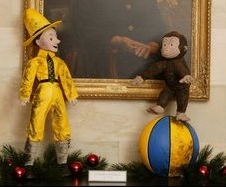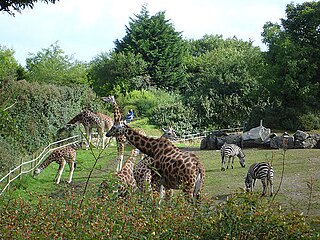
Cheeta is a chimpanzee character that appeared in numerous Hollywood Tarzan films of the 1930s–1960s, as well as the 1966–1968 television series, as the ape sidekick of the title character, Tarzan. Cheeta has usually been characterized as male, but sometimes as female, and has been portrayed by chimpanzees of both sexes.

Taronga Zoo is a government-run public zoo located in Sydney, New South Wales, Australia, in the suburb of Mosman, on the shores of Sydney Harbour. The opening hours are between 9:30 a.m. to 4:30 p.m. Taronga is an Aboriginal word meaning "beautiful view".

The Oklahoma City Zoo and Botanical Garden is a zoo and botanical garden located in Oklahoma City's Adventure District in northeast Oklahoma City, Oklahoma.

The Monkey World Ape Rescue Centre is a 65-acre (26.3 ha) ape and monkey sanctuary, rescue centre and primatarium near Wool, Dorset, England.

Edinburgh Zoo, formerly the Scottish National Zoological Park, is an 82-acre (33 ha) non-profit zoological park in the Corstorphine area of Edinburgh, Scotland.

A pet monkey is a monkey kept as a pet. The practice of keeping monkeys as pets is controversial.

Tarzan and His Mate is a 1934 American pre-Code action adventure film based on the Tarzan character created by Edgar Rice Burroughs. Directed by Cedric Gibbons, it was the second in the Tarzan film series and starred Johnny Weissmuller and Maureen O'Sullivan.

Auckland Zoo is a 16.35-hectare (40-acre) zoological garden in Auckland, New Zealand, situated next to Western Springs Park not far from Auckland's central business district. It is run by Auckland Council with the Zoological Society of Auckland as a supporting organisation.

Belfast Zoological Gardens is a zoo in Belfast, Northern Ireland. It is in a relatively secluded location on the northeastern slope of Cavehill, overlooking Belfast's Antrim Road. Opened in 1934, it is the second-oldest zoo in Ireland, after Dublin Zoo, which opened in 1831.

The Kansas City Zoo & Aquarium is a 202-acre (82 ha) zoo founded in 1909 and is located in Swope Park at 6800 Zoo Drive, Kansas City, Missouri, in the United States. The zoo has a Friends of the Zoo program to help promote the work of the zoo which sees over one million visitors a year. The zoo is home to nearly 1,700 animals and the aquarium has around 8,000 animals. The zoo is an accredited member of the Association of Zoos and Aquariums (AZA).

Sydney Zoo is a zoo in Bungarribee in the Western Sydney Parklands, in Greater Western Sydney, New South Wales, Australia. Sydney Zoo is located 38 kilometres (24 mi) west of the Sydney central business district. It occupies a 16.5-hectare (41-acre) site. Sydney Zoo is a member of the Zoos and Aquariums Association of Australia and New Zealand.

Shanghai Zoological Park, or commonly Shanghai Zoo in short, is the main zoological garden in Shanghai. It is located near the township of Hongqiao and is administratively in Changning District. Shanghai Zoo was formerly known as " Xijiao Park", which is still a common name used locally for the zoo.

In Defense of Animals (IDA) is an animal protection organization founded in 1983 in San Rafael, California, US. The group's slogan is "working to protect the rights, welfare, and habitats of animals".

Geoffrey Gurrumul Yunupingu, commonly known as Gurrumul and also referred to since his death as Dr G. Yunupingu, was a Yolŋu Aboriginal Australian musician. A multi-instrumentalist, he played drums, keyboards, guitar and didgeridoo, but it was the clarity of his singing voice that attracted rave reviews. He sang stories of his land both in Yolŋu languages such as Gaalpu, Gumatj or Djambarrpuynu, a dialect related to Gumatj, and in English. He began his career as a member of Yothu Yindi and later Saltwater Band, and his solo career brought him wider acclaim He was the most commercially successful Aboriginal Australian musician at the time of his death. As of 2020, it is estimated that Yunupingu has sold half a million records globally.
Jiggs was a male chimpanzee and animal actor who originated the character of Cheeta in the 1930s Hollywood Tarzan movies. He was owned and trained by Tony and Jacqueline Gentry.

Nkima is a fictional character in Edgar Rice Burroughs' Tarzan novels, and in adaptations of the saga to other media, particularly comics. His name comes from either the word N'kima, or, after the Meru language nickname for Ugali, a dish popular in Kenya and Tanzania made from maize flour.
Attenborough: 60 Years in the Wild is a three-part BBC documentary series chronicling the 60 years career making wildlife programmes of Sir David Attenborough. The first hour-long programme, titled "Life on Camera" was broadcast on Friday 16 November 2012 on BBC Two at 9pm. The second part, "Understanding the Natural World" and third and final part, "Our Fragile Planet" were broadcast on following Fridays, 23 and 30 November 2012.

Ellis Stanley Joseph was a collector and trader in wildlife in the early part of the 20th century. He also trained some of his captured wildlife, exhibiting them to the public in order to fund his other activities.















